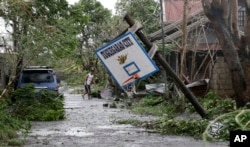Typhoon Mangkhut pummelled China's most populous province of Guangdong Sunday after lashing Hong Kong with heavy rains and winds of up to 200 kilometers.
More than 2.4 million people had been evacuated from Guangdong for what is considered the strongest storm to hit the region this year.
Two people have been reported dead thus far in Southern China, according to Chinese media, after the storm left over 50 people in the Philippines dead.
Hong Kong raised a Number 10 storm warning, its highest alert.
The Hong Kong Observatory made "a special appeal to the members of the public to stay in safe place indoors, and not to go outside," but everyone has not heeded that advice.
"I went running this morning," said 28-year-old Hao Chen. "I love fresh air and there's no one on the streets, no cars. On normal days we can't see this."
Justin, a Canadian tourist in Hong Kong, said, "I came here to actually catch the typhoon, and I have like, a helmet with a camera mount, and I have my waterproof gear for catching good footage of the storm."
Macau, China's gaming center, has shut down all its casinos. The government said in a statement: "The suspension is for the safety of casino employees, visitors to the city and residents."
Mangkhut made its first landfall in the Philippines Saturday, pounding the northern tip of Luzon Island.
Farms across Luzon, the Philippines largest island, are under floodwaters. Luzon farms produce most of the country's rice and corn. Now, however, their crops have been ruined just a month before harvest.
"We have lost hope," 40-year old Mary Anne Baril told the French news agency AFP. Mangkhut ruined Baril's crops. "We have no other means to survive."
Mangkhut has been downgraded from a supertyphoon to a typhoon, but continues to pose a great risk as it travels across the region.
Chinese Foreign Minister Wang Yi was scheduled to begin a trip to the Philippines Sunday, but the two countries have agreed to postpone that visit because of the typhoon. Some 150 flights have been canceled because of Mangkhut, and China's Guangdong province is also in the path of the storm.
Mangkhut arrived with winds of 270 kilometers per hour that ripped the tin roofs off homes and knocked out power lines.
Still, the strength and damage attributed to the storm were gauged to be less than that of Typhoon Haiyan, which left more than 7,300 people dead or missing in the Philippines in 2013.












